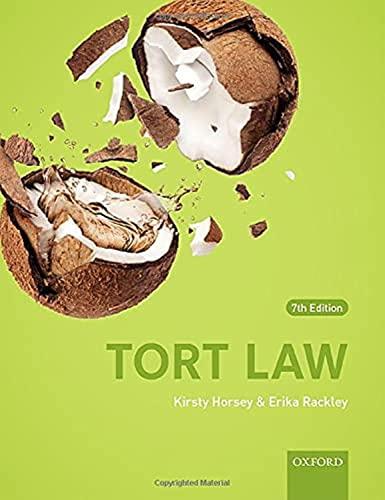Question
Ansell Healthcare Products, Inc., and Becton Dickinson & Co., Inc. v. Owens & Minor, Inc. and Owens & Minor Medical, Inc. 189 S.W.3d 889 Court
Ansell Healthcare Products, Inc., and Becton Dickinson & Co., Inc. v. Owens & Minor, Inc. and Owens & Minor Medical, Inc.
189 S.W.3d 889
Court of Appeals of Texas, Sixth District (2006)
Justice O'Neill
Texas law allows an innocent seller to be indemnified by a manufacturer when the seller issued in a products liability action. Based on that statute, the trial court granted the seller-distributor, Owens & Minor, Inc. and Owens & Minor Medical, Inc. (O&M), a judgment against two manufacturers of latex gloves, Ansell Healthcare Products, Inc. and Becton Dickinson & Company, Inc. (BD).
Janet McCabe found that the latex gloves she had been using in her occupation caused an allergic reaction. In January 2000, she sued more than ten manufacturers of latex gloves supplied to her employers as well as the seller-distributor, O&M. That case settled, and all of the defendants were released by McCabe. However, that was not the end of this lengthy and expensive litigation, but only the beginning.
O&M filed suit against five of the manufacturers, seeking indemnification for its attorney's fees and litigation costs. Claims against three of these were resolved, leaving O&M's claims against Ansell and BD. Texas law provides by statute that the manufacturer must indemnify a seller for the seller's losses, including attorney's fees, arising out of a products liability action. This requirement is imposed regardless of the manner in which the underlying action was Page 168concluded and is in addition to any other duty of indemnity established by law, contract, or otherwise.
Apparently, the suit to enforce the attorney's fees was more complicated than the underlying products liability case, as O&M now alleges it is entitled to collect from the two manufacturers not only the more than $73,000.00 incurred in the original suit but also an additional $310,000.00 for the trial of this case and another $65,000.00 for the appeal. After several summary judgment and other hearings, as well as a bench trial, the trial court found that each of the two manufacturers had an independent obligation for the damages and awarded all of the above to O&M against the two manufacturers as indemnity as authorized by law.
Ansell and BD argue that the trial court erred in finding them independently liable for O&M's entire damages, thereby assigning joint and several liability to the two defendant manufacturers. Ansell and BD point out that joint and several liability was recognized where the tortious acts of two or more wrongdoers were found to have joined and produced one indivisible injury. They argue that since there was no finding of wrongdoing in this case, such analysis does not apply. The manufacturers further reason that joint and several liability is inappropriate because there is no mechanism to apportion any damage award among the manufacturers. Ansell and BD conclude that the Legislature never contemplated that one manufacturer would be held responsible for all costs and fees incurred by a distributor when multiple manufacturers are involved. It is argued that the proper allocation of these damages would be a pro rata distribution of the damages among all manufacturers named in the McCabe petition.
The manufacturers' argument has some logic and appeal. It is true that no party has been found to have caused the underlying damages to McCabe which prompted this action. The damages to O&M occurred in defending the McCabe lawsuit and are only recoverable by statutory authorization since such recovery would not be authorized in common law. Common law indemnity was authorized when the wrongful conduct of one party subjected another party to liability, and recovery could only be for expenditures made to discharge the liability. However, the Legislature's Act granted to seller-distributors remedies that were not previously available, i.e., it applies regardless of the outcome of the underlying case; it includes recovery of attorney's fees and costs.
We believe that Ansell and BD had a duty to indemnify O&M under the statute.
Affirmed.
Case Concepts for Discussion
1. Is it fair that the two manufacturers had to indemnify the supplier? Why?
2. Who benefits under joint and several liability? A plaintiff? Defendants? Why?
Step by Step Solution
There are 3 Steps involved in it
Step: 1

Get Instant Access to Expert-Tailored Solutions
See step-by-step solutions with expert insights and AI powered tools for academic success
Step: 2

Step: 3

Ace Your Homework with AI
Get the answers you need in no time with our AI-driven, step-by-step assistance
Get Started


